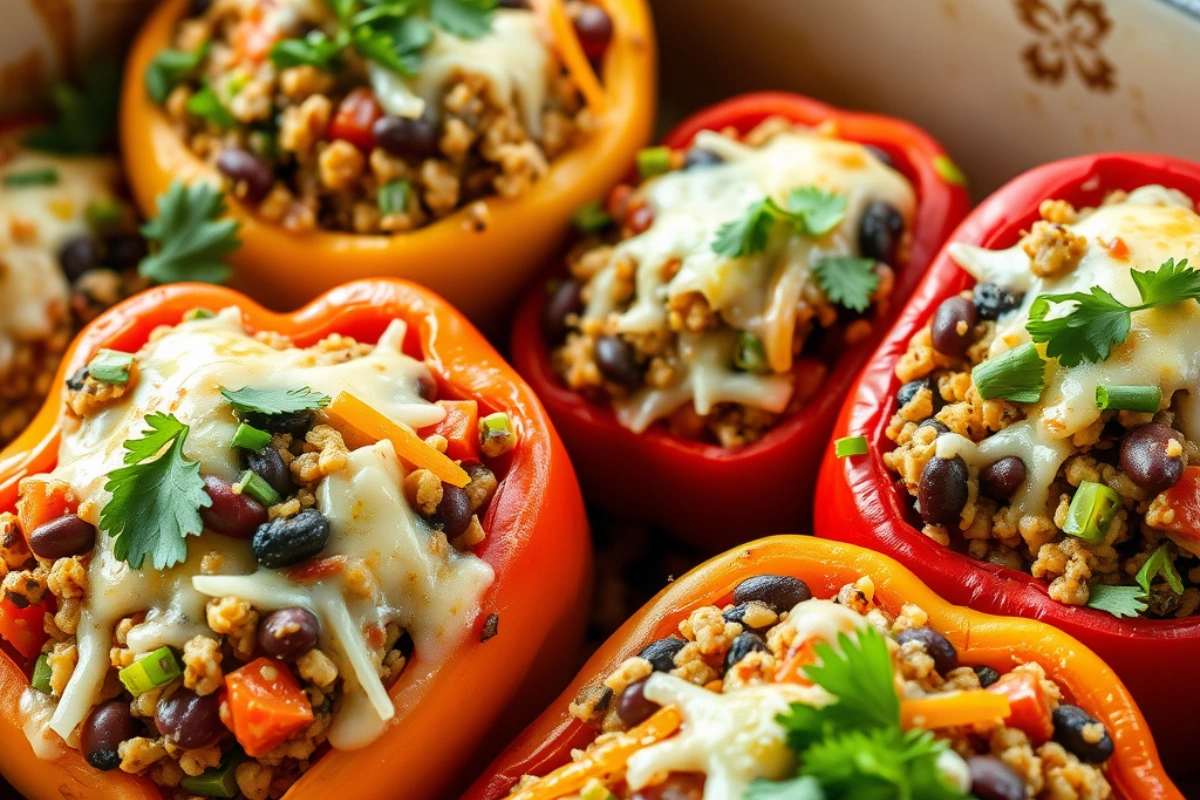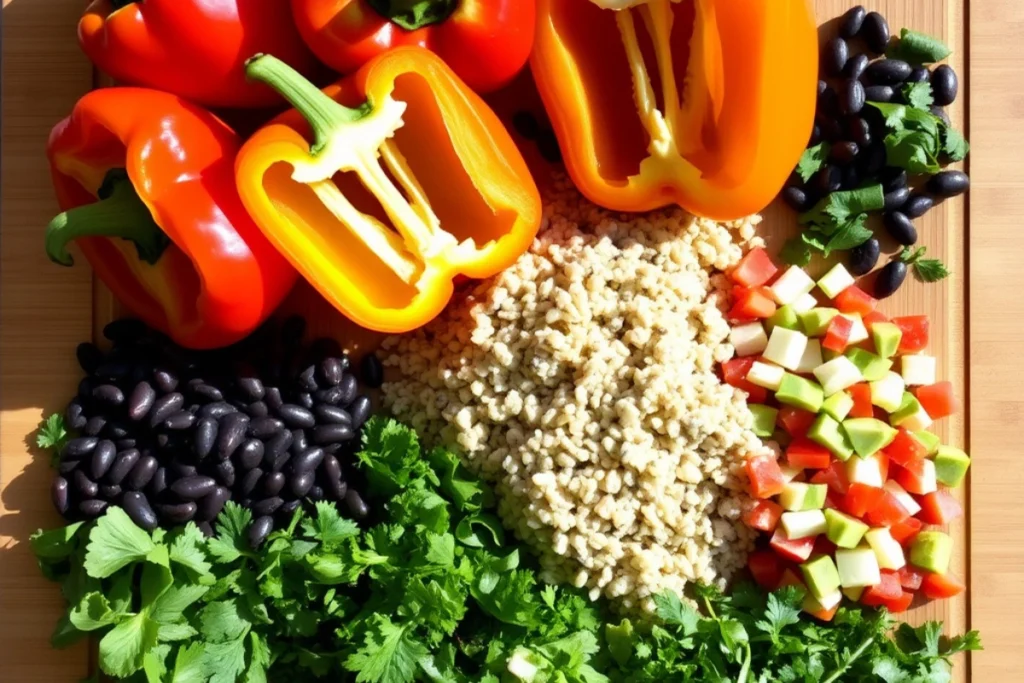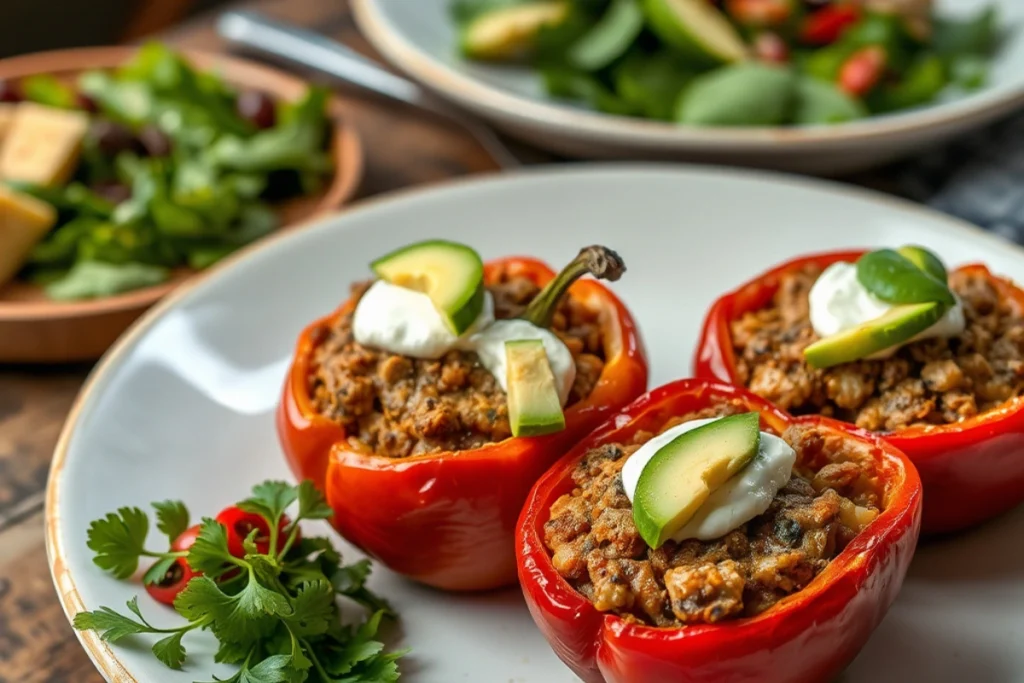Vegan Stuffed Bell Pepper Recipe: A Wholesome and Flavorful Plant-Based Meal
Stuffed bell peppers have always been a favorite comfort food, and transforming them into a vegan dish makes them even more wholesome and versatile. This vegan stuffed bell pepper recipe features fresh, vibrant bell peppers filled with a hearty, plant-based stuffing, creating a meal that is both satisfying and nutritious. Whether it’s for a casual weeknight dinner, meal prep for the week, or a gathering with friends, these stuffed bell peppers deliver on flavor and appeal. For more plant-based inspiration, consider checking out Healthy Vegan Recipes and Vegan Gluten-Free Recipes for additional options that cater to diverse dietary preferences.
What Are Vegan Stuffed Bell Peppers?
A Plant-Based Twist on a Classic Dish
Vegan stuffed bell peppers swap the traditional meat and cheese fillings for plant-based ingredients like grains, legumes, and vegetables. These substitutions make the dish perfect for vegans while boosting its nutritional value. Each bite provides a rich source of fiber, protein, and essential vitamins.
Why Choose Vegan Stuffed Bell Peppers?
This dish is simple yet highly adaptable. Various stuffing combinations, such as quinoa, lentils, or black beans, allow for customization to suit individual tastes and dietary needs. Additionally, it is a convenient one-dish meal, making it an excellent choice for busy evenings or hosting gatherings. More ideas for versatile plant-based dishes can be found in Vegan Dinner Recipe Ideas.
The Nutritional Benefits of Bell Peppers
Bell peppers are colorful and nutritious. They are packed with vitamin C, antioxidants, and fiber. Using them as a base creates a balanced and healthy meal when combined with nutrient-dense fillings.
The Appeal of Stuffed Bell Peppers
Nutritional Benefits of Bell Peppers
Bell peppers are a powerhouse of nutrients. They are rich in vitamin C, which supports immune health and skin vitality. Their antioxidants, such as beta-carotene, help combat free radicals, promoting overall wellness. With their low calorie and high fiber content, bell peppers are an excellent choice for weight management and digestive health.
Versatility of Vegan Stuffing Options
Vegan stuffed bell peppers can be tailored to fit any taste or dietary requirement. Grains like quinoa, rice, or couscous provide a hearty base. Proteins such as lentils, black beans, or chickpeas make the dish filling and satisfying. Add sautéed vegetables, fresh herbs, and spices to bring out the flavors, creating endless possibilities for customization.
Sustainability of Plant-Based Ingredients
Choosing plant-based fillings for stuffed bell peppers contributes to a more sustainable diet. These ingredients typically have a lower environmental impact compared to animal-based products. Using seasonal vegetables further reduces your carbon footprint while ensuring maximum freshness and flavor.
Ingredients for Vegan Stuffed Bell Peppers
Core Ingredients
- Bell Peppers: Choose red, green, yellow, or orange peppers for variety. They act as the perfect vessel for the stuffing.
- Grains: Quinoa, rice, or farro work well as a hearty base. Choose gluten-free grains like quinoa if needed.
- Protein: Black beans, lentils, chickpeas, or crumbled tofu add protein and texture.
- Vegetables: Sautéed onions, zucchini, spinach, or mushrooms enhance the flavor and nutritional value.
Seasonings and Herbs
- Spices: Cumin, smoked paprika, garlic powder, and onion powder provide a savory base.
- Herbs: Fresh parsley, cilantro, or basil add brightness and balance.
- Salt and Pepper: Adjust to taste for seasoning.
Sauce or Toppings
- Tomato Sauce: Use marinara or a homemade tomato base for moisture and flavor.
- Vegan Cheese: Sprinkle shredded vegan cheese or drizzle with a cashew cream sauce for richness.
- Optional Toppings: Avocado slices, nutritional yeast, or vegan sour cream complete the dish.
Substitutions and Customizations
- Swap grains for cauliflower rice to lower carbs.
- Replace black beans with kidney beans or pinto beans for variety.
- Use gluten-free breadcrumbs as a topping for added crunch.
Step-by-Step Instructions for the Recipe
Preparing the Ingredients
Begin by rinsing the bell peppers thoroughly under cold water. Slice them lengthwise and carefully remove the seeds and membranes to create a hollow cavity for stuffing. Meanwhile, prepare your chosen grain, such as quinoa, rice, or farro, according to the package instructions. Once cooked, fluff the grains with a fork and set them aside to cool slightly. At the same time, cook or rinse your protein, like lentils, black beans, or chickpeas, and drain any excess liquid to prevent the filling from becoming too wet. Next, heat a skillet over medium heat and add a small amount of oil, or use water if you prefer oil-free cooking. Sauté chopped onions, zucchini, mushrooms, or spinach until tender and fragrant. In a large mixing bowl, combine the cooked grains, protein, sautéed vegetables, seasonings, and a few tablespoons of tomato sauce. Gently stir the ingredients until evenly combined.
Assembling the Bell Peppers
Spoon the prepared stuffing mixture into each bell pepper half and press gently to ensure the filling stays securely in place. Once filled, drizzle each stuffed pepper with tomato sauce and sprinkle vegan cheese or breadcrumbs on top, depending on your preference.
Baking Instructions
Preheat the oven to 375°F (190°C) and line a baking dish with parchment paper or lightly grease it to prevent sticking. Arrange the stuffed peppers neatly in the prepared baking dish, cover with foil to retain moisture, and bake for 25–30 minutes. Remove the foil and bake for an additional 10 minutes to brown the tops. Finally, ensure the peppers are tender and the filling is heated through before removing them from the oven.
Pro Tips for Perfect Results
Firmer peppers retain their shape better during baking, preventing them from collapsing. For softer peppers, pre-bake the halved peppers for 5 minutes before adding the stuffing. Avoid overfilling the peppers and be cautious with the amount of sauce you use to prevent sogginess.
Nutritional Information (per 100g)
| Calories | Protein (g) | Carbs (g) | Fat (g) |
|---|---|---|---|
| 200 | 7 | 30 | 4 |
Variations of Vegan Stuffed Bell Peppers
Mediterranean-Inspired Stuffing
For a Mediterranean twist, start by using couscous as the grain base. Next, mix it with ingredients like olives, sundried tomatoes, chickpeas, and artichoke hearts. To enhance the flavor, season with oregano, thyme, and a drizzle of olive oil. Finally, top the peppers with crumbled vegan feta or fresh parsley to bring out the Mediterranean essence.
Mexican-Inspired Stuffing
If bold flavors are the goal, a Mexican-inspired stuffing works well. Black beans, corn, and quinoa create a hearty base, while spices such as cumin, chili powder, and smoked paprika add depth and warmth. Salsa or enchilada sauce can be used as a flavorful topping to enhance the dish. Sliced avocado or a sprinkle of nutritional yeast adds creaminess and a hint of cheesiness, rounding out the flavors. For similar recipes with a Mexican flair, Vegan Mexican Recipe Ideas highlights other plant-based options.
Italian-Inspired Stuffing
To create an Italian version, start by combining cooked farro or rice with marinara sauce, sautéed spinach, and diced zucchini. For added richness, mix in vegan mozzarella or parmesan cheese. After seasoning the stuffing with garlic, basil, and oregano, finish with a sprinkle of vegan parmesan after baking.
Protein-Packed Variation
For a protein-rich option, use lentils or crumbled tofu as the main ingredient. Then, mix these with quinoa or brown rice and flavor with spices such as turmeric, coriander, or curry powder. To add texture, include diced bell peppers or carrots. Finally, top with a dollop of vegan sour cream to balance the flavors.
Low-Carb Option
If you’re looking for a low-carb version, replace grains with cauliflower rice. Combine the cauliflower rice with diced vegetables such as mushrooms, onions, and zucchini. Moreover, season with garlic and Italian herbs to elevate the taste. Add a spoonful of marinara or tomato sauce for moisture, and top with nutritional yeast for a cheesy touch.
Benefits of Vegan Stuffed Bell Peppers
Health Benefits
Vegan stuffed bell peppers offer a wide range of health advantages. They are naturally low in calories and high in fiber, which supports digestion and promotes feelings of fullness. For additional fiber, ingredients such as quinoa, lentils, and black beans provide plant-based protein that aids muscle repair and overall health. Bell peppers are also a rich source of vitamin C, antioxidants, and essential nutrients, making them both nutritious and flavorful. More examples of fiber-rich vegan dishes can be found in Vegan High-Fiber Recipes. Information on versatile plant-based protein options is available in Plant-Based Protein Meal Ideas, and Healthy Vegan Recipes showcases other nutrient-dense meal ideas.
Environmentally Friendly Choice
Choosing vegan stuffed bell peppers contributes to a sustainable lifestyle. By using plant-based ingredients, you significantly reduce the carbon footprint associated with traditional meat-based meals. Furthermore, incorporating seasonal vegetables into the recipe minimizes environmental impact while enhancing flavor. As awareness of sustainable eating grows, dishes like these play a crucial role in promoting eco-friendly choices.
Versatility for Dietary Preferences
One of the greatest benefits of vegan stuffed bell peppers is their adaptability. Whether you’re gluten-free, low-carb, or seeking to boost protein intake, this dish can be customized to suit your dietary needs. For instance, replacing grains with cauliflower rice creates a low-carb option, while adding tofu or legumes increases protein content. This versatility ensures that everyone can enjoy the meal without compromise.
Perfect for Any Occasion
Vegan stuffed bell peppers are suitable for various occasions. They work well as a quick weekday dinner, a meal-prep option, or a dish for a dinner party. Their colorful presentation and rich flavors make them both eye-catching and satisfying. Moreover, their one-dish nature simplifies preparation and cleanup, making them a favorite for busy cooks.
Storing and Reheating Vegan Stuffed Bell Peppers
Storing Leftovers
Proper storage is essential to maintain the freshness and flavor of vegan stuffed bell peppers. To store leftovers, allow the peppers to cool completely before placing them in an airtight container. You can keep them in the refrigerator for up to four days. If you need to store them for longer, freezing is an excellent option. Simply wrap each stuffed pepper individually in plastic wrap or aluminum foil, then place them in a freezer-safe container. This method ensures they remain intact and easy to reheat.
Freezing Tips
Before freezing, consider whether you want to freeze the peppers before or after baking. If freezing before baking, stuff the peppers as usual and place them directly in the freezer. For cooked peppers, ensure they are fully cooled before freezing. Label the container with the date to keep track of storage time, as frozen peppers stay fresh for up to three months.
Reheating Methods
When it’s time to enjoy your stored stuffed peppers, reheating them properly will preserve their texture and flavor. For refrigerated peppers, use the oven by preheating it to 350°F (175°C) and baking the peppers for 15–20 minutes. Alternatively, you can microwave them on medium power for 2–3 minutes per pepper, checking to ensure they are heated through. For frozen peppers, thaw them in the refrigerator overnight before reheating, or bake them directly from frozen for 25–30 minutes.
Batch Cooking Tips
If you’re meal prepping, making a large batch of vegan stuffed bell peppers can save time and effort throughout the week. After cooking, store individual portions for quick, ready-to-eat meals. This approach is especially convenient for busy weeknights or when planning for lunches. Additionally, freezing extras ensures you always have a healthy and satisfying meal on hand.
Frequently Asked Questions (FAQs)
Can I Freeze Vegan Stuffed Bell Peppers?
Yes, vegan stuffed bell peppers freeze exceptionally well. To freeze, prepare the peppers as usual and decide whether to bake them first or freeze them raw. If freezing before baking, stuff the peppers and place them in a freezer-safe container. For cooked peppers, let them cool completely before wrapping them individually in foil or plastic wrap. Store in the freezer for up to three months.
What Are the Best Grains for Stuffing?
Quinoa, rice, couscous, and farro are excellent grains for stuffing bell peppers. Quinoa is particularly popular due to its high protein content and fluffy texture. For a gluten-free option, use rice or quinoa, while couscous and farro provide a hearty base for those who don’t require gluten-free alternatives.
How Do I Prevent Bell Peppers from Getting Soggy?
To prevent sogginess, avoid overloading the peppers with liquid ingredients. Additionally, you can pre-bake the bell peppers for 5–10 minutes before adding the stuffing, as this helps them retain their structure. Using firmer bell peppers also ensures they hold up better during cooking.
Can This Recipe Be Made Oil-Free?
Yes, you can make this recipe oil-free. Use water or vegetable broth to sauté the vegetables instead of oil. Additionally, skip any oil-based toppings or marinades. This adjustment doesn’t compromise flavor and keeps the recipe suitable for those avoiding oil.
What Vegan Toppings Work Best for Stuffed Bell Peppers?
Vegan toppings such as nutritional yeast, cashew cream, avocado slices, or shredded vegan cheese work beautifully with stuffed bell peppers. Tomato-based sauces or salsas can also enhance the flavor profile while keeping the dish moist and delicious.
Can I Use Different Types of Bell Peppers?
Yes, you can use any color bell peppers, including red, yellow, green, or orange. Red and yellow peppers tend to be sweeter, while green peppers have a slightly bitter taste. Choosing a mix of colors adds variety and visual appeal to the dish.
Conclusion
Vegan stuffed bell peppers are a perfect blend of flavor, nutrition, and versatility. This plant-based dish replaces traditional meat-based fillings with wholesome ingredients like grains, legumes, and fresh vegetables, making it a healthier and more sustainable option. Packed with fiber, protein, and essential nutrients, these stuffed peppers are ideal for weeknight dinners, meal prep, or gatherings with family and friends.
Their adaptability allows for endless variations, from Mediterranean-inspired flavors to protein-packed options. You can customize the stuffing to suit dietary preferences, ensuring everyone at the table can enjoy this vibrant dish. Whether you’re making them fresh or storing leftovers for later, vegan stuffed bell peppers are an easy, satisfying meal that fits seamlessly into a plant-based lifestyle.
By incorporating simple preparation steps, practical storage tips, and creative topping ideas, this recipe proves that plant-based cooking can be both delicious and convenient. Vegan stuffed bell peppers truly showcase the beauty and versatility of plant-based ingredients.


